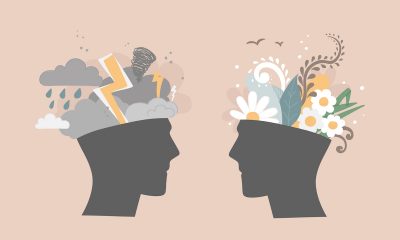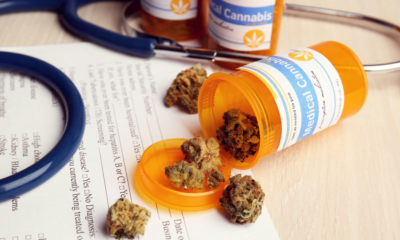Consultant psychiatrist and cannabis clinician, Dr Tahzid Ahsan, delves deeper into the nuances of prescribing and the key points for both patients and doctors to consider.
In this article, I will reflect in more detail about the nuances of prescribing and the important points for patients to be aware of, starting with psychiatric conditions.
Before a patient receives their prescription, their case has to go through a peer-review process where independent doctors will decide if they are eligible for medicinal cannabis.
The main criteria for eligibility is having a diagnosed (noted on GP/medical records) mental health condition and evidence of two treatments trialled for a reasonable period of time, with no risks of suicide or mania/psychosis/schizophrenia noted.
This criteria isn’t black and white, so it’s important to be honest about one’s own medical history during the consultation.
Patients are usually asked to come back after one month for a follow up and then every three months thereafter, but will be seen sooner if there are any issues. Between consultations, they can be reviewed by a GP, mental health nurse or pharmacist.
Overall, there is very good evidence to suggest that medical cannabis helps with chronic pain and anxiety and moderate evidence for its use in fibromyalgia, PTSD and insomnia, with some evidence that it helps with symptoms of ADHD and autism.
There is ongoing collection of real-world evidence via Drug Science’s patient registry T21. So far, pain and anxiety have been noted as the main reasons people are prescribed cannabis.
After three months, patients reported significant improvements in quality of life, mood and sleep scores (the reported effects were better than those of antidepressants to treat major depression for the same length of time).
READ MORE: How to access a medical cannabis prescription: step-by-step
The philosophy behind medical cannabis prescribing
Prescribed medical cannabis comes in different forms, the main two being oils and cannabis flowers.
The oils are taken as drops under the tongue (sublingually), held for a few minutes and then swallowed, absorbing very quickly into the bloodstream to have an onset of effect between 20 minutes to one hour, lasting up to four to eight hours.
Ground cannabis flower is placed into a medical cannabis dry herb vape chamber, with starting temperatures of 160℃- 170℃ , increasing it by 5℃ until reaching around 195℃ in order to utilise the terpenes that have different boiling points. The boiling points for the major terpenes are; Pinene 156℃; Caryophyllene 165℃; Myrcene 167℃; Limonene 176℃ and Linalool 198℃.
After inhalation the effect is almost immediate, lasting from a few minutes to a few hours.
The fundamental philosophy I share with all my patients, whether cannabis naive or not, is to take the ‘go low, go slow, listen to your own flow’ poetic advice, meaning ‘listen to your mind, body and spirit’.
My advice is to start as and when required, before increasing the dosages gradually depending on the patient’s needs. The aim is to achieve clinical effectiveness, maintain a steady tolerance level, and keep costs down.
The medications can cost between £150-£200 pounds for 30g, which usually lasts for a month. Each pack measures around 5g to 10g each. Oil can also cost between £150 -£200 pounds for a 30ml-50ml size bottle.
During the cost of living crisis, I have noted that patients are taking medications due to what they can afford rather than clinical need. (This is a real shame and is why I believe the NHS should subsidise medical cannabis especially when patients have reached their treatment end goal through the NHS).
The oil bottles arrive supplied with a pipette measuring between 0.1ml- 1 ml. The cannabis flowers are usually ground up in measurements of 0.1- 0.25g placed in dosing capsules to use in the dry herb chamber.
For new cannabis patients, I would usually prescribe a high CBD:THC ratio oil, usually a 20:1 ratio, with as little THC as possible. I would ask them to start off at 0.1- 0.2ml at a time, increasing it gradually depending on the patient’s needs, to a maximum of 1ml per day.
If symptoms persist, I would add a small amount of THC at night in an Indica form. Even for more experienced users, it is still important to start with a higher ratio of CBD:THC, slowly increasing to 3-6 mg of THC per day.
Cannabis flower prescriptions make up to 60% of all prescriptions. It is the most feared aspect for doctors due to the many different types and varieties of flowers available.
All the flowers fall within a spectrum of THC:CBD ratios, terpenes and flavonoids, indica and sativa hybrid ratios, giving each flower its unique effect and benefits. Names of strains such as Royal Moby or Green Gelato describe the genetic makeup of the flowers (and make prescribing that much more fun!)
Due to the immediate effect and fluidity of usage, patients can take the flower aligned to their needs, adjusting doses and frequency accordingly.
Applying the ‘go low, go slow’ approach, I ask my patients to use 0.1- 0.2g, placing into a dry herb chamber starting at 170℃, taking a few inhalations at a time whilst grading the temperatures upwards by 5℃ to 195℃, with the average maximum daily usage of 1g.
Side effects, concerns around psychosis and safety
The main side effects according to the likelihood of them occurring are disorientation, dizziness, euphoria and dry mouth.
Many of my colleagues are understandably concerned by the risks of long-term side effects such as psychosis and even schizophrenia. Cannabis may exacerbate already present psychotic symptoms or trigger an episode in a patient who is genetically predisposed, i.e. their mother/father or sibling has a diagnosis of schizophrenia. However, cannabis does not directly cause the onset of psychosis or schizophrenia.
Other side effects include short-term memory loss, but there is no evidence to suggest impairment of long-term memory.
The Quebec Cannabis Registry released a report in Dec 2022 on its investigation analysing the safety and effectiveness of medical cannabis in a real-world setting. The conclusion reached was that prescribed medical cannabis appears to be safe and effective within three months of initiation for many medical indications such as pain, anxiety and tiredness.
Driving and employment
Unfortunately the legislation around driving doesn’t include any specific guidance for medical cannabis users.
If your saliva test by the police is shown to be positive and subsequent blood test levels of 2 (mcg/L) THC are found, you are likely to be convicted.
However, Section 5A of the Road Traffic Act provides a statutory defence for medical cannabis users who are not impaired but are over the legal limit. If you are prescribed medical cannabis, the DVLA advises that you inform them.
It is also important to have honest discussions with employers, especially if you work with complicated machinery.
What to do next for doctors and patients
Both patients and doctors can feel alone during their respective medical cannabis journeys. The stigmas that are attached to cannabis are still rife within our society, silencing any evolving narrative around medical cannabis.
I have been lucky enough to be part of developing Medbud, an essential non-for-profit resource providing a comparative tool for both patients and doctors alike, in order to help them navigate the terrain of the UK medical cannabis system.
It allows you to see a complete directory of clinics and pharmacies in the UK, including which flowers and oils are available, their THC:CBD content, terpene ratios and costs.
A must read is Cannabis: seeing through the smoke by Professor David Nutt.
For doctors, I highly recommend joining the Medical Cannabis Clinicians Society (MCCS), a place to share knowledge amongst prescribers, and completing the Sativa Learning course that has become the foundation of my medical cannabis knowledge and CPD accreditations. (Sign up here for 10% off)
In next month’s article, I will reflect upon the experiences of medical cannabis patients in clinical case studies of conditions including fibromyalgia, PTSD and Emotionally Unstable Personality Disorder (EUPD).

Dr Tahzid Ahsan
Read the first article in the series The doctor’s perspective: becoming a medical cannabis prescriber
Dr Tahzid Ahsan is a consultant psychiatrist and cannabis prescriber. Dr Ahsan is looking for volunteer cannabis users to be interviewed for a new book about the effects of medical cannabis from the patients perspective. Anyone interested please contact: volunteercannabiscalm@gmail.com
Home » Cannabis explained » The doctor’s perspective: Everything you need to know about prescribing medical cannabis

 News6 months ago
News6 months ago
 Science5 months ago
Science5 months ago
 Industry6 months ago
Industry6 months ago
 News6 months ago
News6 months ago
 News5 months ago
News5 months ago
 Health5 months ago
Health5 months ago
 News5 months ago
News5 months ago
 Health3 months ago
Health3 months ago













